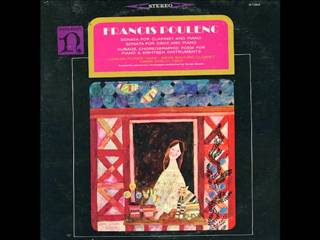Francis Poulenc – Aubade (1964)
Francis Poulenc – Aubade (1964)

00:00 - 1. Toccata (lento e pesante) 02:53 - 2. Récitatif I (larghetto) 04:50 - 3. Rondeau (allegro) 07:50 - 4. Presto 09:21 - 5. Récitatif II (larghetto) 11:43 - 6. Andante (andante con moto) 14:51 - 7. Allegro féroce 15:32 - 8. Conclusion (adagio) Jacques Février (piano) Concerts Lamoureux Orchestra Serge Baudo - conductor
Poulenc's Aubade is a curious if charming blend of piano concerto, ballet, and chamber salon piece. The work's unconventional makeup and manageable scale were in some part determined by its origins: It was commissioned by Poulenc's friends (and noted patrons and salon hosts) Marie-Laure and Charles de Noailles. A concert version was premiered December 1, 1929 in the couple's townhouse, followed by a full stage version on January 21, 1930.
Aubade is segmented into eight movements: Toccata, Récitatif, Rondeau, Presto, Récitatif, Andante, Allegro féroce, and Conclusion (Adagio). Given its hybrid structure, it is less a strict piano concerto than a modern cousin to Rameau's opéra-ballets in the galant style. That said, Poulenc fashioned his musical materials with great care and sophistication, blending themes which borrow from such sources as Stravinsky's Le Sacre du printemps and Petrushka, as well as Mozart's keyboard works. Poulenc also incorporates two melodies from earlier minor piano works -- a Sérénade from Trois pièces (1928) and the Première nocturne (1929) -- which serve to unify the various strands of Aubade. The music alternates between Stravinskian percussiveness and Mozartean lyricism, at the same time incorporating several brass fanfares, gracious eighteenth century rondos and moments of Lisztian grandiosity.
Poulenc described Aubade as "amphibious," implying that the role of protagonist is more or less shared between the onstage woman dancer and the pianist in the orchestra pit. The ballet is a series of tableaux said to be inspired by paintings from the École de Fontainebleau. At the work's center is Diana, the mythological huntress, who finds herself "burning with a love that consumes her purity." Awaking at dawn in the forest of Fontainebleau, she is dressed by her woman friends. Condemned to chastity and despondent over an impure love, she dances a variation, clasping to her breast a bow her friends had given her. Suddenly, she throws the bow away and darts into the woods.
The choreographer for the Paris production was George Balanchine, who ignored Poulenc's plot for the dance, introducing a handsome, muscular dancer to portray Actéon in a pas de deux with Diana. The composer complained that Aubade was to be exclusively "a woman's ballet," but Balanchine ultimately had his way. The ballet was designed by Jean-Michel Frank, who redid the interior of the Noailles' home with fanciful, stylized sets. ---Brian Wise, Rovi
download: uploaded yandex 4shared mediafire solidfiles mega gett filecloudio nornar ziddu
Zmieniony (Wtorek, 18 Marzec 2014 14:51)








